1. 概要
古人云: 工欲善其事,必先利其器.
学习一种新的开发, 就要先了解其开发工具 和 项目结构. 目前WPF 项目的开发工具 常用的是 Visual Studio, 也有其他开发工具如: Rider. 这里使用微软官方的开发工具 -- Visual Studio(以下简称VS)
2. 新建项目/解决方案
打开 VS, 新建项目, 页面如下:
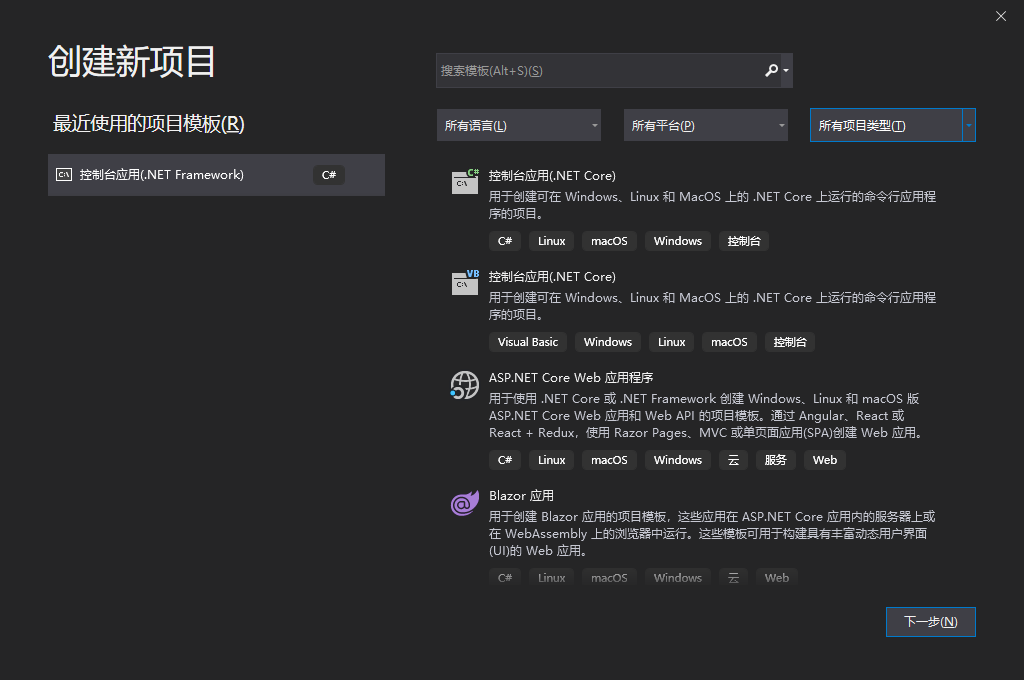
选择 C#语言 Windows平台 桌面项目, 这里选择创建 .Framework 应用:
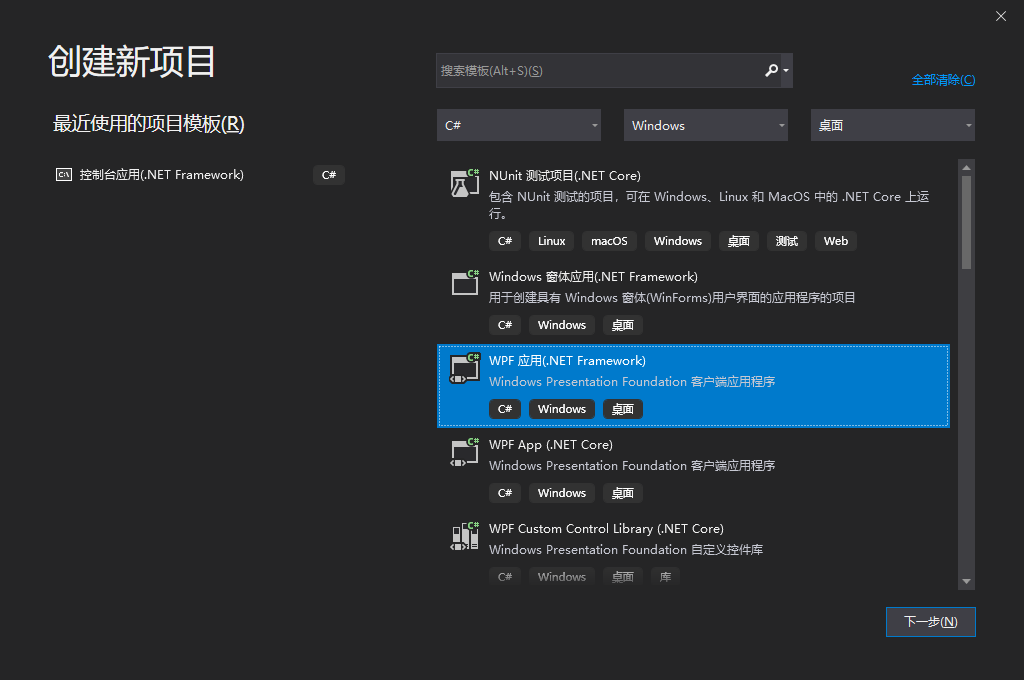
点击 下一步, 填写 项目名称, 选择框架版本. 如果是单独项目解决方案 就勾选 放置在同一个目录, 如果是多项目的解决方案 就不勾选.
下图为 解决方案和项目放在同一个目录
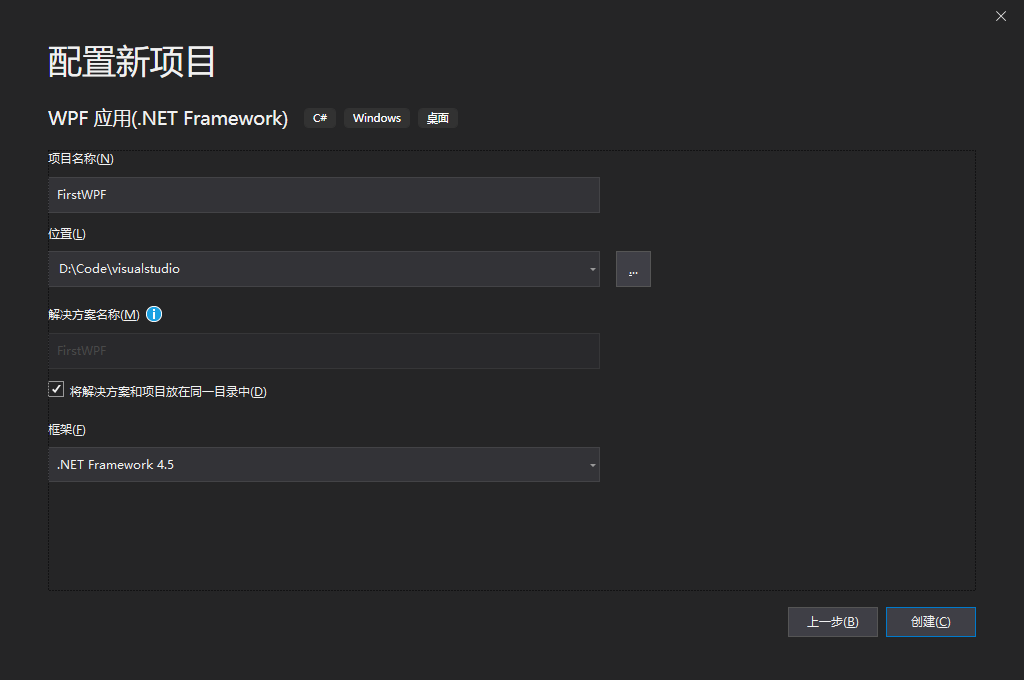
下图为 不勾选 解决方案和项目放在同一个目录中
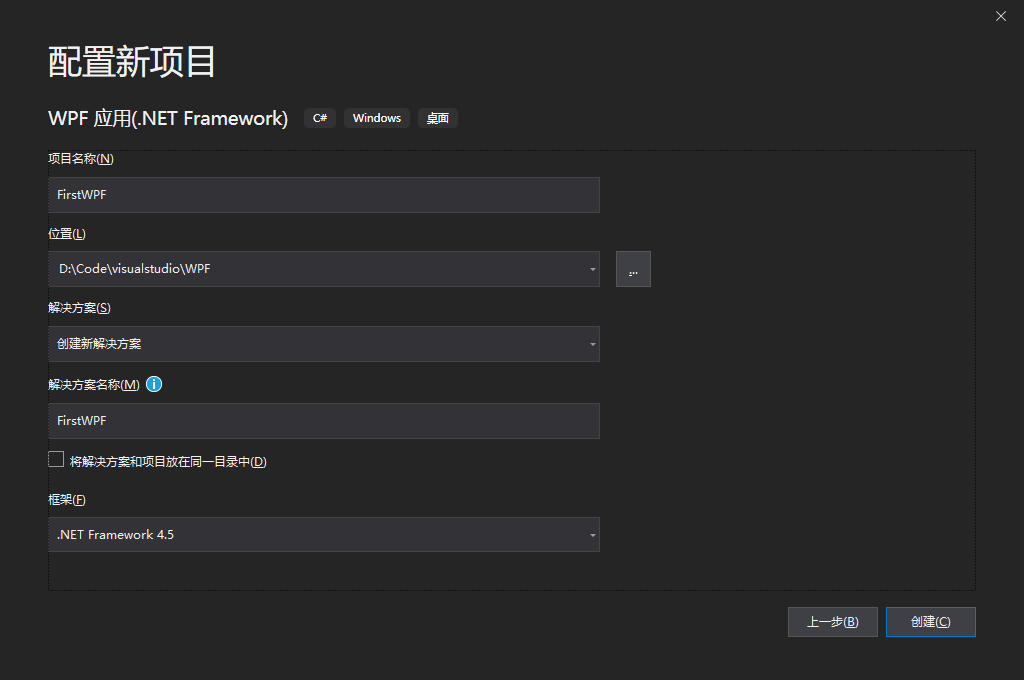
点击创建, VS 会自动创建新项目.
3. 解决方案和项目的目录结构
创建WPF 项目以后, 切换到 解决方案资源管理查看项目结构:
下图为 解决方案和项目不同目录的默认目录结构图
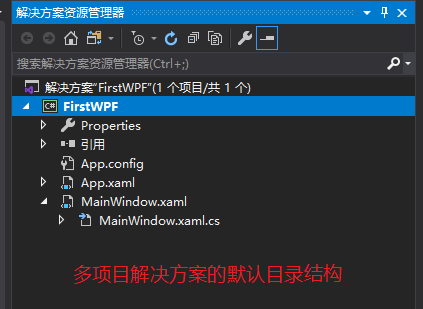
下图为解决方案和项目同一个目录的目录结构图
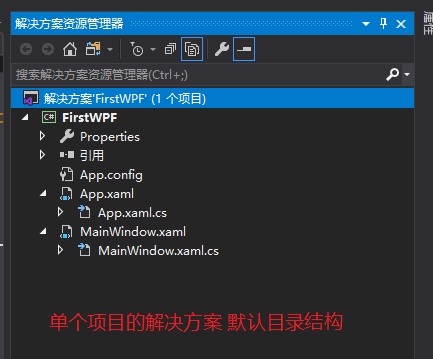
从上图基本看不出差别, 唯一的差别在于解决方案的标题提: "解决方案"FirstWPF"" 后面的说明:
- 解决方案"FirstWPF"(1个项目/共1个)
- 解决方案"FirstWPF"(1个项目)
但是从资源管理器查看文件夹,可以看出不同:
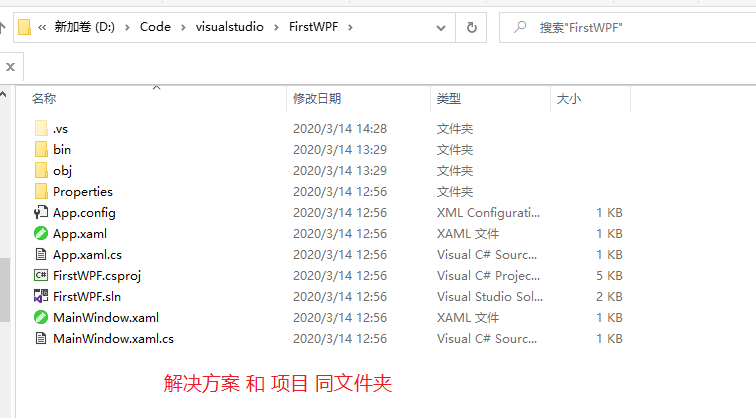

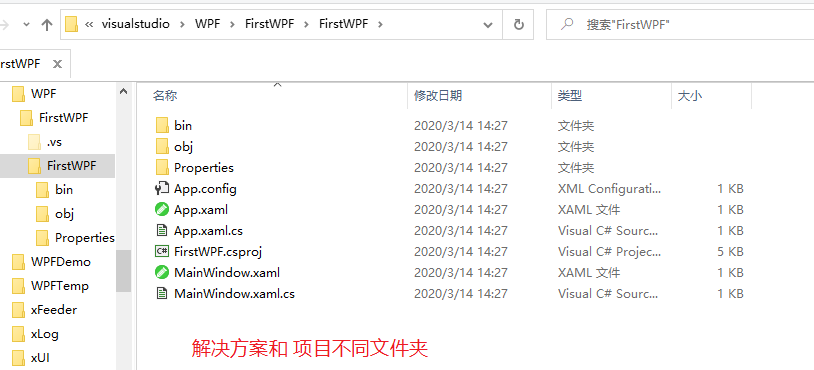
从上图可以看出区别是 将 .vs文件夹 和 FirstWPF.sh 文件移动到 和 FirstWPF项目文件夹同一个层级. 其中:
- FirstWPF.sh : 此文件为解决方案的配置文件
- FirstWPF.csproj : 此文件为 项目的配置文件
我们打开两个不同创建方式的 解决方案配置文件查看内容, 发现不同的地方:
## 同一个目录的 解决方案部分内容
Project("{FAE04EC0-301F-11D3-BF4B-00C04F79EFBC}") = "FirstWPF", "FirstWPF.csproj", "{28D50E34-3BD6-4AF0-8B56-FF05F054DAAF}"
## 不同一个目录的 解决方案部分内容
Project("{FAE04EC0-301F-11D3-BF4B-00C04F79EFBC}") = "FirstWPF", "FirstWPF\FirstWPF.csproj", "{13EAA442-8D8A-4848-9996-39F215B9C57D}"4. WPF项目的目录结构
在VS 的 解决方案资源管理器中 , 可以切换显示模式:
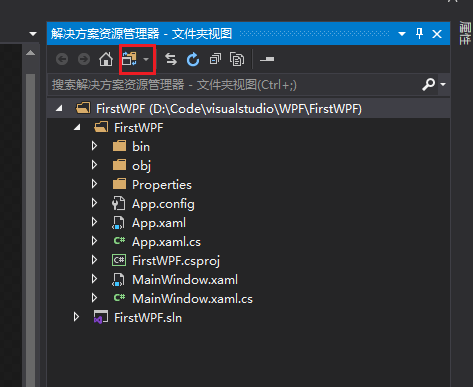
上图中我们可以看到 WPF 工程的项目结构, 其用途如下:
FirstWPF : 解决方案的名字
FirstWPF : 项目的名字
bin/ : 用来保存项目生成后的程序集, 一般有 Debug 和 Release 两个版本.我们可以通过:项目属性—>配置属性—>输出路径来修改
- Debug
- Release
obj/ : 保存每个模块的编译结果, 对应的会有 Debug 和 Release两个目录
- Debug
- Release
Properties : 项目属性文件夹
- AssemblyInfo.cs : 程序集配置信息文件, 可以修改
- Resources.Designer.cs : VS 自动生成的资源设计视图, 打开如下面的"资源管理视图"
- Resources.resx : 和上面的 Resources.Designer.cs 一起组成资源管理视图
- Settings.Designer.cs : VS自动生成项目配置视图
- Settings.settings : 应用程序设置允许动态存储和索引应用程序的属性设置和其他信息.
- App.config : 项目的属性配置文件
- App.xaml : 项目入口 Application 类的子类的xaml 文件
- App.xaml.cs : 项目的入口 Application 类的子类
- FirstWPF.csproj : 项目结构配置文件
- MainWindow.xaml : 默认的第一个界面的设计文件
- MainWindow.xaml.cs : 默认的第一个界面的代码文件
在解决方案资源管理器 切换到工程模式显示如下:
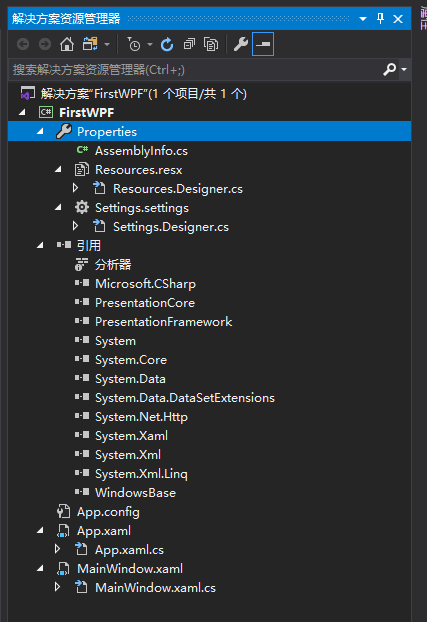
双击 Properties 会显示 项目配置的 UI 界面:
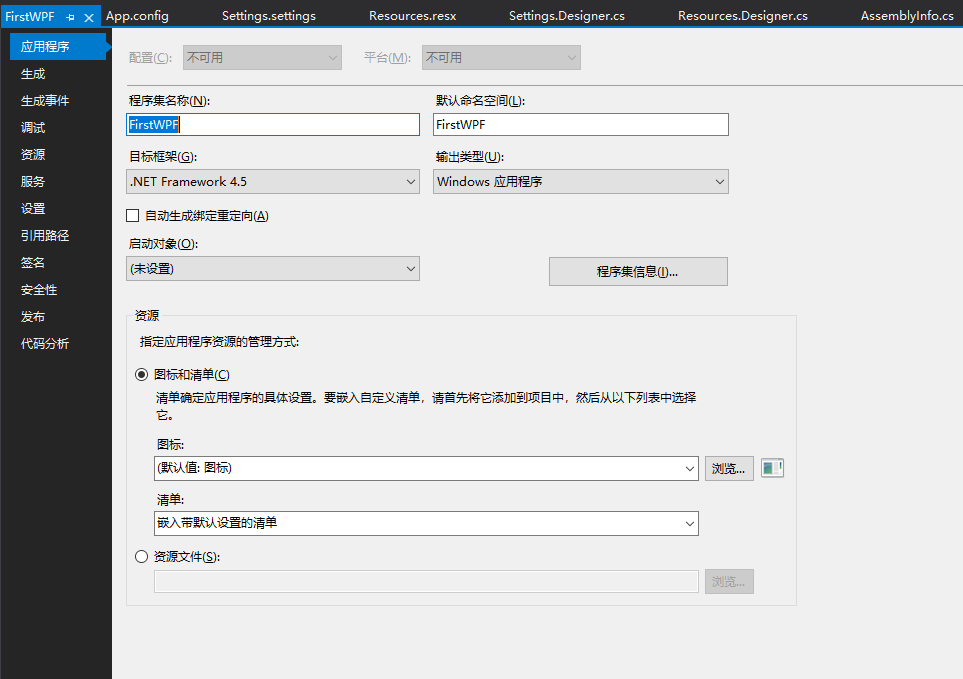
双击 Resources.resx会显示资源管理视图: 资源管理视图

双击 Settings.settings 会显示设置视图:

5. WPF项目的接口默认内容
5.1 项目文件 FirstWPF.csproj
打开FristWPF.csproj文件, 内容如下 :
<?xml version="1.0" encoding="utf-8"?>
<Project ToolsVersion="15.0" xmlns="http://schemas.microsoft.com/developer/msbuild/2003">
<Import Project="$(MSBuildExtensionsPath)\$(MSBuildToolsVersion)\Microsoft.Common.props" Condition="Exists('$(MSBuildExtensionsPath)\$(MSBuildToolsVersion)\Microsoft.Common.props')" />
<PropertyGroup>
<Configuration Condition=" '$(Configuration)' == '' ">Debug</Configuration>
<Platform Condition=" '$(Platform)' == '' ">AnyCPU</Platform>
<ProjectGuid>{13EAA442-8D8A-4848-9996-39F215B9C57D}</ProjectGuid>
<OutputType>WinExe</OutputType>
<RootNamespace>FirstWPF</RootNamespace>
<AssemblyName>FirstWPF</AssemblyName>
<TargetFrameworkVersion>v4.5</TargetFrameworkVersion>
<FileAlignment>512</FileAlignment>
<ProjectTypeGuids>{60dc8134-eba5-43b8-bcc9-bb4bc16c2548};{FAE04EC0-301F-11D3-BF4B-00C04F79EFBC}</ProjectTypeGuids>
<WarningLevel>4</WarningLevel>
<Deterministic>true</Deterministic>
</PropertyGroup>
<PropertyGroup Condition=" '$(Configuration)|$(Platform)' == 'Debug|AnyCPU' ">
<PlatformTarget>AnyCPU</PlatformTarget>
<DebugSymbols>true</DebugSymbols>
<DebugType>full</DebugType>
<Optimize>false</Optimize>
<OutputPath>bin\Debug\</OutputPath>
<DefineConstants>DEBUG;TRACE</DefineConstants>
<ErrorReport>prompt</ErrorReport>
<WarningLevel>4</WarningLevel>
</PropertyGroup>
<PropertyGroup Condition=" '$(Configuration)|$(Platform)' == 'Release|AnyCPU' ">
<PlatformTarget>AnyCPU</PlatformTarget>
<DebugType>pdbonly</DebugType>
<Optimize>true</Optimize>
<OutputPath>bin\Release\</OutputPath>
<DefineConstants>TRACE</DefineConstants>
<ErrorReport>prompt</ErrorReport>
<WarningLevel>4</WarningLevel>
</PropertyGroup>
<ItemGroup>
<Reference Include="System" />
<Reference Include="System.Data" />
<Reference Include="System.Xml" />
<Reference Include="Microsoft.CSharp" />
<Reference Include="System.Core" />
<Reference Include="System.Xml.Linq" />
<Reference Include="System.Data.DataSetExtensions" />
<Reference Include="System.Net.Http" />
<Reference Include="System.Xaml">
<RequiredTargetFramework>4.0</RequiredTargetFramework>
</Reference>
<Reference Include="WindowsBase" />
<Reference Include="PresentationCore" />
<Reference Include="PresentationFramework" />
</ItemGroup>
<ItemGroup>
<ApplicationDefinition Include="App.xaml">
<Generator>MSBuild:Compile</Generator>
<SubType>Designer</SubType>
</ApplicationDefinition>
<Page Include="MainWindow.xaml">
<Generator>MSBuild:Compile</Generator>
<SubType>Designer</SubType>
</Page>
<Compile Include="App.xaml.cs">
<DependentUpon>App.xaml</DependentUpon>
<SubType>Code</SubType>
</Compile>
<Compile Include="MainWindow.xaml.cs">
<DependentUpon>MainWindow.xaml</DependentUpon>
<SubType>Code</SubType>
</Compile>
</ItemGroup>
<ItemGroup>
<Compile Include="Properties\AssemblyInfo.cs">
<SubType>Code</SubType>
</Compile>
<Compile Include="Properties\Resources.Designer.cs">
<AutoGen>True</AutoGen>
<DesignTime>True</DesignTime>
<DependentUpon>Resources.resx</DependentUpon>
</Compile>
<Compile Include="Properties\Settings.Designer.cs">
<AutoGen>True</AutoGen>
<DependentUpon>Settings.settings</DependentUpon>
<DesignTimeSharedInput>True</DesignTimeSharedInput>
</Compile>
<EmbeddedResource Include="Properties\Resources.resx">
<Generator>ResXFileCodeGenerator</Generator>
<LastGenOutput>Resources.Designer.cs</LastGenOutput>
</EmbeddedResource>
<None Include="Properties\Settings.settings">
<Generator>SettingsSingleFileGenerator</Generator>
<LastGenOutput>Settings.Designer.cs</LastGenOutput>
</None>
</ItemGroup>
<ItemGroup>
<None Include="App.config" />
</ItemGroup>
<Import Project="$(MSBuildToolsPath)\Microsoft.CSharp.targets" />
</Project>1. ToolsVersion
此属性的含义是 MSBuild 的版本, 此部分说明在官方的 MSBuild 说明文档中:
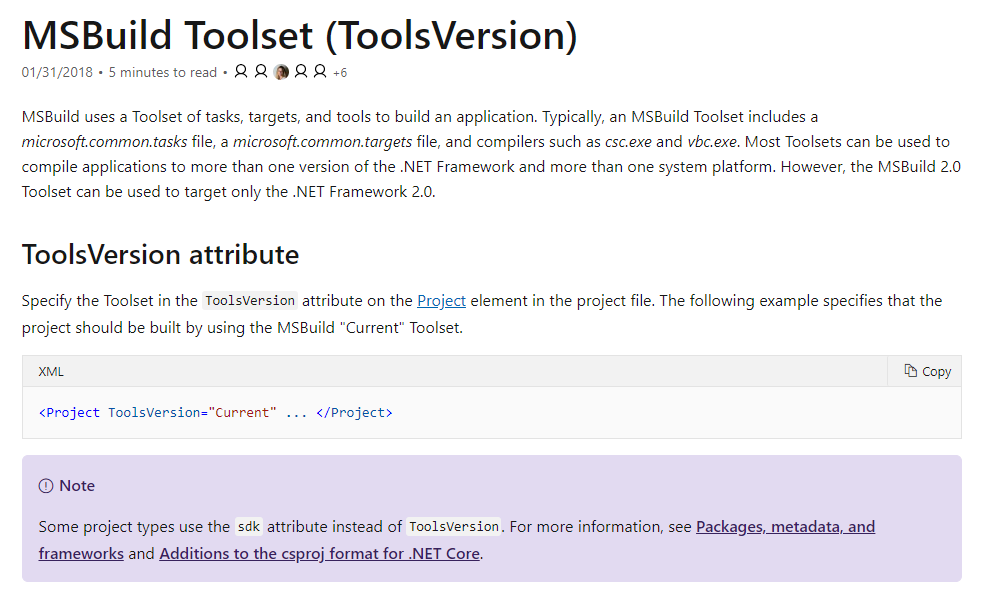
2. PropertyGroup
接着的三个 PropertyGroup 分别配置了项目的构建类型: Debug | Release, 包括了:
- Configuration : 配置名称
- Platform : 运行平台
- ProjectGuid : 项目的guid
- OutputType: 输出类型 , win exe
- RootNamespace : 根命名空间的名字
- AssemblyName : 程序集名称
等等一些配置信息. 我们打开配置管理器可以看到 UI界面:
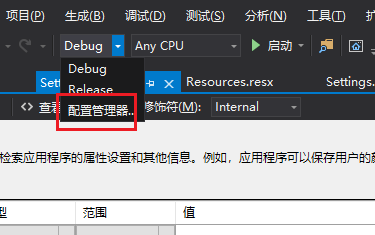
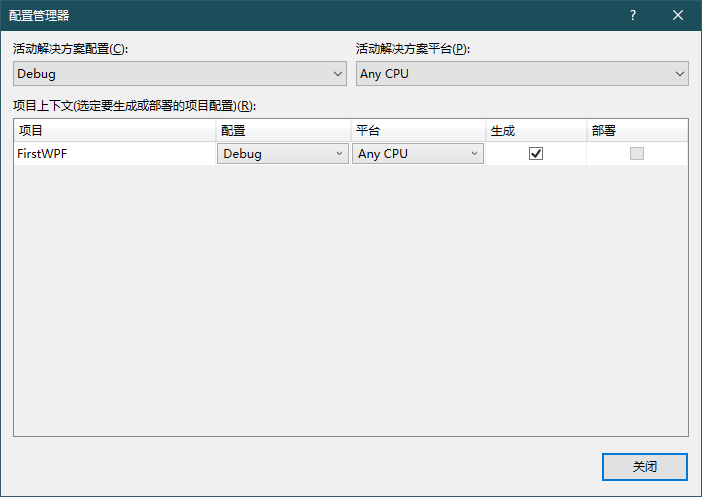
3. Reference ItemGroup
下面的 ItemGroup 是引用信息, 默认引用了以下内容:
- System : 包含用于定义常用值和引用数据类型、事件和事件处理程序、接口、特性以及处理异常的基础类和基类。
- System.Data: 提供对表示 ADO.NET 结构的类的访问。 通过 ADO.NET,可以生成可有效管理多个数据源的数据的组件。
- System.Xml : 标准的 xml 支持
- Microsoft.CSharp : 包含支持使用 C# 语言编译和生成代码的类
- System.Core : 引用 System.Core.dll
- System.Xml.Linq : 包含 LINQ to XML 的类。 LINQ to XML 是内存中的 XML 编程接口,可以轻松有效地修改 XML 文档。
- System.Data.DataSetExtensions : 引用 DataSetExtensions.dll
- System.Net.Http : 提供用于现代 HTTP 应用程序的编程接口。
- System.Xaml : 提供与 XAML 读取器和 XAML 编写器相关的类型。
- WindowsBase: Window 基础dll
- PresentationCore : 动态链接文件库
- PresentationFramework : 动态链接文件库
4. 项目文件的 ItemGroup
接着的几个 ItemGroup为 项目的文件索引,包含:
- ApplicationDefinition : 项目的Application的 xaml和cs文件
- Page : 项目UI 界面
- Properties 目录下的文件
- App.config 文件
5.2 App.config
打开 App.config 文件 可以看到以下内容:
<?xml version="1.0" encoding="utf-8" ?>
<configuration>
<startup>
<supportedRuntime version="v4.0" sku=".NETFramework,Version=v4.5" />
</startup>
</configuration>配置了 项目启动时所需的 环境为 .NETFramework 4.5
5.3 AssembleInfo.cs
此文件为程序集的配置信息, 包含内容如下:
using System.Reflection;
using System.Resources;
using System.Runtime.CompilerServices;
using System.Runtime.InteropServices;
using System.Windows;
// 有关程序集的一般信息由以下
// 控制。更改这些特性值可修改
// 与程序集关联的信息。
[assembly: AssemblyTitle("FirstWPF")]
[assembly: AssemblyDescription("")]
[assembly: AssemblyConfiguration("")]
[assembly: AssemblyCompany("")]
[assembly: AssemblyProduct("FirstWPF")]
[assembly: AssemblyCopyright("Copyright © 2020")]
[assembly: AssemblyTrademark("")]
[assembly: AssemblyCulture("")]
// 将 ComVisible 设置为 false 会使此程序集中的类型
//对 COM 组件不可见。如果需要从 COM 访问此程序集中的类型
//请将此类型的 ComVisible 特性设置为 true。
[assembly: ComVisible(false)]
//若要开始生成可本地化的应用程序,请设置
//.csproj 文件中的 <UICulture>CultureYouAreCodingWith</UICulture>
//例如,如果您在源文件中使用的是美国英语,
//使用的是美国英语,请将 <UICulture> 设置为 en-US。 然后取消
//对以下 NeutralResourceLanguage 特性的注释。 更新
//以下行中的“en-US”以匹配项目文件中的 UICulture 设置。
//[assembly: NeutralResourcesLanguage("en-US", UltimateResourceFallbackLocation.Satellite)]
[assembly: ThemeInfo(
ResourceDictionaryLocation.None, //主题特定资源词典所处位置
//(未在页面中找到资源时使用,
//或应用程序资源字典中找到时使用)
ResourceDictionaryLocation.SourceAssembly //常规资源词典所处位置
//(未在页面中找到资源时使用,
//、应用程序或任何主题专用资源字典中找到时使用)
)]
// 程序集的版本信息由下列四个值组成:
//
// 主版本
// 次版本
// 生成号
// 修订号
//
//可以指定所有这些值,也可以使用“生成号”和“修订号”的默认值
//通过使用 "*",如下所示:
// [assembly: AssemblyVersion("1.0.*")]
[assembly: AssemblyVersion("1.0.0.0")]
[assembly: AssemblyFileVersion("1.0.0.0")]5.4 App.xaml和App.xaml.cs
此文件为 Application 的子类, 继承默认的WPF项目类内容, 同时可以扩展自己的配置, 类似于 Android 中的 Application 类. 其内容如下:
App.xaml
<Application x:Class="FirstWPF.App"
xmlns="http://schemas.microsoft.com/winfx/2006/xaml/presentation"
xmlns:x="http://schemas.microsoft.com/winfx/2006/xaml"
xmlns:local="clr-namespace:FirstWPF"
StartupUri="MainWindow.xaml">
<Application.Resources>
</Application.Resources>
</Application>在 Appli.Resources Tag里面可以配置 项目级别的资源引用.
App.xaml.cs
namespace FirstWPF
{
/// <summary>
/// App.xaml 的交互逻辑
/// </summary>
public partial class App : Application
{
}
}此类中可以监听应用的启动, 关闭等回调:
namespace FirstWPF
{
/// <summary>
/// App.xaml 的交互逻辑
/// </summary>
public partial class App : Application
{
protected override void OnStartup(StartupEventArgs e)
{
base.OnStartup(e);
}
protected override void OnExit(ExitEventArgs e)
{
base.OnExit(e);
}
}
}5.5 MainWindow 文件
此文件 为默认的第一个界面的代码, 其布局文件为只包含Grid 的空布局:
<Window x:Class="FirstWPF.MainWindow"
xmlns="http://schemas.microsoft.com/winfx/2006/xaml/presentation"
xmlns:x="http://schemas.microsoft.com/winfx/2006/xaml"
xmlns:d="http://schemas.microsoft.com/expression/blend/2008"
xmlns:mc="http://schemas.openxmlformats.org/markup-compatibility/2006"
xmlns:local="clr-namespace:FirstWPF"
mc:Ignorable="d"
Title="MainWindow" Height="450" Width="800">
<Grid>
</Grid>
</Window>对应的代码文件包含了初始化处理:
namespace FirstWPF
{
/// <summary>
/// MainWindow.xaml 的交互逻辑
/// </summary>
public partial class MainWindow : Window
{
public MainWindow()
{
InitializeComponent();
}
}
}6. 后记
至此, WPF项目的基本结构说明就到此, 后续根据项目需要可以增加修改文件和内容, 如添加 多个资源文件参见另一篇文章: WPF APP项目添加资源文件夹 - DevWiki
欢迎关注我的公众号获取最新的文章, 或者 移步我的博客

















